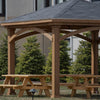How to Build a Shed Foundation

Before you bring your dream shed to life, knowing how to build a shed foundation will be the key to its success. While it might be tempting to skip this step and place the shed directly on the ground, doing so invites a host of problems that could compromise its longevity and functionality.
Why Shed Foundations Are Important
A solid foundation ensures your shed sits on a stable, level surface, which keeps it secure and prevents doors from sticking or misaligning. It also protects the structure from ground moisture, reducing the risk of wood rot and decay by allowing for proper drainage and ventilation beneath the shed. Though it may require some extra effort upfront, a well-built foundation is an investment in the durability and performance of your shed for years to come.
Determine if You Need a Building Permit for Your Shed
Prior to picking the perfect spot for your shed, take a moment to navigate the rules and regulations in your area. Whether it’s your local Homeowners Association (HOA) or the county Building Department, a quick consultation can save you from potential headaches later. Permits and guidelines vary widely, so don’t skip this step—it’s essential to ensure your shed project goes smoothly and complies with local codes.
Here’s what to confirm with your HOA or Building Department:
- Shed type and size: Are there restrictions on dimensions or styles? Frost line: Understand the depth to prevent shifting in colder climates.
- Location: Are there setback requirements or placement restrictions?
- Foundation type: Is a specific foundation required for your area?
- Building permits: What permits (if any) are needed for your shed project?
Do You Need a Foundation for Your Shed?
For smaller sheds, like those around 6×8 or less, a foundation might not seem essential. However, even for compact sheds, we recommend using a foundation because it provides crucial support, ensures proper ventilation, and helps keep your shed in great shape for years to come.
Where Should You Build Your Shed Foundation?
Pick a location that’s nearly level (within six inches is ideal) and avoids areas prone to pooling water. To make maintenance and access easy, leave at least three feet of clearance around smaller sheds. For larger storage buildings, like a 10×16 shed or bigger, allow for at least four feet of breathing room. This extra space makes moving around your shed a breeze and prevents obstacles from crowding your structure.
Heartland Sheds Foundation Requirements: *Prior to the arrival of the installer, your build site must be level within 6”. Additional charges may apply if this requirement is not met. We require 3’ of clearance on all sides for installations and 4’ for buildings 160 square feet or larger.
Determine Your Frost Line:
The frost line is the depth at which water in the soil is expected to freeze during colder months. This might sound technical, but it’s important. In regions with harsh winters, the natural freeze-thaw cycle can cause structures to shift or become unstable. That’s where knowing your local frost line comes into play—it ensures your shed foundation is stable and protected from seasonal ground movement.
In general, the frost line gets deeper the closer you are to the poles, but specifics vary based on your location. To find your area's frost line, contact your local HOA or building department. You can also check out this frost line map for a quick reference by state.
Gather the Necessary Tools
- Chalk reels
- Concrete leveling blocks
- Tape measure
- Hammer
- Level
What are the Shed Foundation Types:
Sheds can be built on the following types of foundations:
- Concrete floor
- Concrete piers
- Compacted gravel
- Wood foundations
If you’re looking for shed foundation ideas, we’re spotlighting wood and concrete. These are our go-to storage shed foundation choices for durability and long-term performance.
Wood Shed Foundations
Wood shed foundations are typically built using solid concrete blocks measuring 16”W x 8”L x 2”H, pea gravel, 4×4 pressure-treated lumber, and a wooden floor frame. Concrete leveling blocks can be purchased separately with any Heartland order.
Follow these step-by-step instructions to create a reliable wood foundation that sets the stage for a durable and long-lasting structure:
- Begin by laying out your floor size and locating pea gravel and concrete blocks. Place each block 12” from each corner of the floor frame.
- Place the concrete blocks on pea gravel.
- Use the pea gravel to level your foundation. Blocks along the same floor joist should be a maximum of 72” apart. The spacing between blocks on different floor joists should be a maximum of 48” apart (See floor layout below).
- Once all blocks are located, place the 4×4s onto the blocks and continue by building your floor frame and securing the frame to the 4×4s. The 4×4's allow proper ventilation underneath your shed. Once the floor frame is built, you can easily level your shed using either more or less pea gravel in various spots.
These are the estimated number of concrete blocks you’ll need based on shed size (more will be required for any surface that is unlevel):
| Shed Size | Number of Blocks | Shed Size | Number of Blocks |
|---|---|---|---|
| 6X6 | 8 | 12x12 | 16 |
| 8X8 | 8 | 12x16 | 22 |
| 8X6 | 8 | 12x20 | 26 |
| 8X10 | 10 | 12x24 | 30 |
| 8X12 | 12 | 16x20 | 50 — *Piers or foundation may be required by state |
| 10X10 | 14 | 16x24 | 55 — *Piers or foundation may be required by state |
| 10X12 | 16 | ||
| 10x16 | 20 |

Click on the image to see enlarged.
Concrete Shed Foundations
For a strong and dependable shed foundation, a concrete slab is another option we highly recommend. It’s durable, low-maintenance, and provides a solid base to keep your shed secure for years to come. Heartland does not employ, endorse, or in any way recommend any qualified concrete specialists for sheds. It is the responsibility of the homeowner to ensure compliance to these specs.

Here are some guidelines for setting up your concrete shed foundation:
- The build site must be level and should have natural drainage and no standing water. This will keep excess moisture away from the foundation and extend your shed’s life.
- Your concrete slab should be minimally the same width and depth as the shed. We use MCA- or ACQ-treated plates around the entire perimeter of the walls. Customers can choose to leave the bottom plate attached behind the door or have it cut out.
- The slab can be no greater than 1/2” out of “square” and no more than a 1/4’’ out of “level.” Any variation to this will cause delays or even stop the installation process. 1/4” out of level at the floor can lead to more than 1” out of level at the roof depending on building size and roof style.
- Based on “local code requirements,” wedge-style anchor bolts should be set in the concrete around the entire perimeter (12” from corners and 4’ on center thereafter) of the slab (except where the door goes), projecting approx. 2 ½” above the slab grade and approx. 1-3/4” to 2” from the edge of the slab. Minimum anchor embedment should be 2-1/2”-3” into the concrete. We recommend ½” diameter x 8-½” long Simpson Wedge.
- Your finished concrete slab surface needs to be at a minimum of 4″ above grade.
REMEMBER: You should ensure that your region allows this type of foundation and that your foundation conforms to all applicable zoning and/or building codes.

What is the Best Shed Foundation?
Wood and concrete are our preferred types of shed foundations. Refer to the chart below to see how they compare:
| Wood Foundations | Concrete Foundations | ||
|---|---|---|---|
| Advantages | Disadvantages | Advantages | Disadvantages |
| Most economical | Can sink slightly over time | Can place wood frame directly on concrete slab | Soil can cause settlement over time |
| Easy to move concrete blocks to the desired location | Not suitable for slopes greater than 24” | Full support of shed frame | More costly |
| Great for most sheds | Not suitable to store cars or boats | Can secure shed/walls to concrete floor | May require professional help that further increases costs |
| Does not require much excavating | Can store cars or boats | ||
Purchasing a shed can be a big investment. However, preparing your foundation properly will help ensure your shed is ready to handle the elements 365 days a year. If you have any questions, feel free to give us a call at 800-234-6167.
Tackling a shed installation not your idea of a good time? Let us handle it for you. Our professional shed installation services ensure a seamless process, so you can sit back and enjoy your new space without lifting a finger.
How to Build a Storage Shed
How to Shingle a Shed
Other Links:
Shed Buyer’s Guide
FAQ’S



























